Biodegradable Packaging Material Market
Biodegradable Packaging Material Market Size and Share Forecast Outlook 2025 to 2035
Biodegradable packaging material market is projected to grow from USD 531.1 billion in 2025 to USD 1,025.6 billion by 2035, at a CAGR of 6.8%. Bio-plastic will dominate with a 51.0% market share, while pouches and bags will lead the product format segment with a 26.0% share.
Biodegradable Packaging Material Market Forecast and Outlook 2025 to 2035
The global biodegradable packaging material market is projected to reach USD 1,025.6 billion by 2035, recording an absolute increase of USD 494.5 billion over the forecast period. The market is valued at USD 531.1 billion in 2025 and is set to rise at a CAGR of 6.8% during the assessment period.
Quick Stats for Biodegradable packaging material Market
- Biodegradable packaging material Market Value (2025): USD 531.1 billion
- Biodegradable packaging material Market Forecast Value (2035): USD 1,025.6 billion
- Biodegradable packaging material Market Forecast CAGR: 6.8%
- Leading Material in Biodegradable packaging material Market: Bio-plastic
- Key Growth Regions in Biodegradable packaging material Market: Asia Pacific, Europe, and North America
- Top Players in Biodegradable packaging material Market: Mondi, Smurfit Westrock, DS Smith, Stora Enso, Sonoco Products Company, Tetra Pak, Amcor plc, Elevate Packaging, Notpla Limited, Greenhope
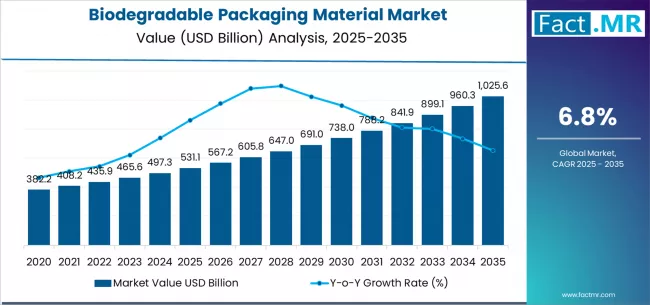
The overall market size is expected to grow by approximately 1.9 times during the same period, supported by increasing government regulations banning single-use plastics and mounting consumer awareness about environmental impacts worldwide, driving demand for compostable packaging alternatives and increasing investments in bio-based material technologies and circular economy solutions globally.
The food and beverage and consumer goods sectors face mounting pressure to eliminate conventional plastic packaging and adopt environmentally responsible alternatives while meeting evolving retailer mandates for packaging reduction, with modern biodegradable packaging material products providing documented environmental degradation capabilities and comparable performance characteristics compared to traditional petroleum-based packaging materials.
Rising corporate commitments and expanding legislative frameworks development across emerging economies create substantial opportunities for material suppliers and brand owners. However, higher production costs and limited composting infrastructure may pose obstacles to widespread commercial adoption.
The bio-plastic segment dominates market activity with approximately 51.0% share in 2025, driven by the extensive application base preferring versatile material solutions with proven biodegradation properties across food packaging, consumer goods, and e-commerce applications worldwide. Brand owners increasingly recognize the functional advantages of bio-plastic packaging, with typical product offerings providing effective barrier protection and structural integrity at competitive performance standards through established manufacturing processes.
The paper and paperboard segment demonstrates robust growth potential with 34.0% share, supported by rising circular economy principles and renewable resource mandates driving preference for fiber-based materials and recyclable solutions in modern packaging systems.
Pouches and bags emerge as the critical product format category with a 26.0% share in 2025, reflecting industry emphasis on flexible packaging conversion and lightweight alternatives for retail distribution. Food and beverages applications represent the dominant end-use segment with 42.0% share, driven by stringent food safety requirements and comprehensive packaging needs across fresh produce, prepared meals, and beverage container applications.
Regional dynamics show Asia Pacific maintaining market leadership, supported by aggressive plastic reduction policies and massive consumer markets across China, India, and Southeast Asian nations. Europe demonstrates strong regulatory enforcement driven by Single-Use Plastics Directive implementation and established waste management infrastructure, while North America emphasizes corporate sustainability commitments and state-level legislative action. India leads country-level growth at 9.1% CAGR through strong adoption across fast-moving consumer goods and food delivery sectors, followed by China at 8.4% supported by large-scale bans on single-use plastics.
The competitive landscape features moderate concentration with Mondi holding a 12.4% market share, while established players including Smurfit Westrock, DS Smith, and Stora Enso compete through comprehensive product portfolios and advanced material science capabilities across diverse packaging applications.
Biodegradable Packaging Material Market Year-over-Year Forecast 2025 to 2035
Between 2025 and 2029, the biodegradable packaging material market is projected to expand from USD 531.1 billion to USD 690.7 billion, resulting in a value increase of USD 159.6 billion, which represents 32.3% of the total forecast growth for the period. This phase of development will be shaped by rising demand for compostable food packaging solutions in retail applications, regulatory implementation of single-use plastic bans with enforcement mechanisms, as well as expanding corporate commitments to packaging circularity and zero-waste initiatives. Companies are establishing competitive positions through investment in bio-based material production facilities, advanced barrier coating technologies, and strategic partnerships across food service, retail, and e-commerce applications.
From 2029 to 2035, the market is forecast to grow from USD 690.7 billion to USD 1,025.6 billion, adding another USD 334.9 billion, which constitutes 67.7% of the overall expansion. This period is expected to be characterized by the expansion of specialized material applications, including advanced bio-polymer formulations and multi-layer compostable structures tailored for specific product protection requirements, strategic collaborations between packaging manufacturers and waste management operators, and an enhanced focus on industrial composting infrastructure and end-of-life certification standards. The growing emphasis on extended producer responsibility schemes and rising consumer preference for home-compostable packaging formats will drive demand for comprehensive biodegradable packaging material solutions across diverse applications.
Biodegradable Packaging Material Market Key Takeaways
| Metric | Value |
|---|---|
| Market Value (2025) | USD 531.1 billion |
| Market Forecast Value (2035) | USD 1,025.6 billion |
| Forecast CAGR (2025-2035) | 6.8% |
Why is the Biodegradable Packaging Material Market Growing?
The biodegradable packaging material market grows by enabling brand owners and retailers to eliminate plastic pollution and achieve environmental commitments while accessing functional packaging solutions without substantial performance compromise requirements. Consumer goods companies and food service operators face mounting pressure to transition away from conventional plastics and demonstrate circular economy leadership while managing diverse product protection needs across distribution channels and end-use applications, with modern biodegradable packaging material products typically providing comparable barrier properties and shelf-life protection compared to traditional petroleum-based packaging alternatives, making material substitution essential for environmental responsibility positioning.
The packaging industry's need for regulatory compliance capabilities and consumer acceptance characteristics creates demand for comprehensive biodegradable solutions that can provide adequate product protection, maintain visual appeal standards, and ensure predictable end-of-life degradation without compromising supply chain efficiency or brand presentation requirements. Government initiatives banning single-use plastics and implementing extended producer responsibility programs drive adoption in retail environments, food service establishments, and e-commerce applications, where packaging choices have direct impact on waste generation and environmental outcomes.
The European Union's Single-Use Plastics Directive and similar legislative frameworks across numerous countries have created structural market shifts in packaging material selection, supporting sustained demand for certified compostable and biodegradable alternatives across all industry sectors. Rising consumer environmental consciousness in developed markets enables brand differentiation through packaging innovation with validated sustainability credentials. However, cost premium constraints compared to conventional plastics and limited industrial composting facility availability may limit adoption rates among price-sensitive categories and regions with underdeveloped waste management infrastructure.
Segmental Analysis
The market is segmented by material, product format, end use, and region. By material, the market is divided into bio-plastic, paper and paperboard, and bagasse. Based on product format, the market is categorized into pouches and bags, boxes and cartons, bottles and jars, films and wraps, trays and clamshells, cups and bowls, cans, and others.
By end use, the market includes food and beverages, personal care and cosmetics, pharmaceuticals, homecare, and others. Regionally, the market is divided into Asia Pacific, Europe, North America, Latin America, and mea.
By Material, Which Segment Accounts for the Dominant Market Share?
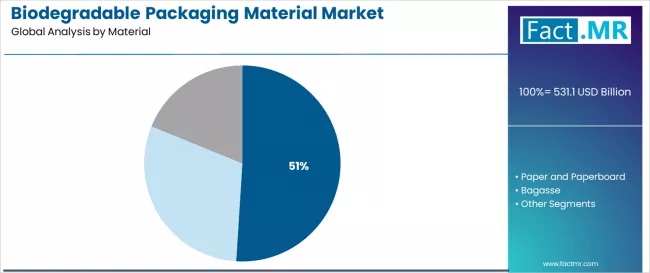
The bio-plastic segment represents the dominant force in the biodegradable packaging material market, capturing 51.0% of total market share in 2025. This category encompasses solutions featuring proven compostability characteristics and functional performance properties, including advanced polylactic acid formulations and polyhydroxyalkanoate compositions that enable superior application versatility and processing compatibility across flexible packaging, rigid containers, and specialty coating applications worldwide.
The bio-plastic segment's market leadership stems from its superior functional advantages, with materials capable of addressing diverse packaging requirements while maintaining structural integrity standards and broad processing adaptability across all manufacturing platforms.
The paper and paperboard segment maintains a substantial 34.0% market share, serving brand owners who require renewable fiber-based solutions with established recycling infrastructure for secondary packaging, shipping containers, and display applications.
These materials offer familiar processing capabilities for converters and brands while providing sufficient protection to meet contemporary distribution requirements. The paper and paperboard segment demonstrates strong growth potential, driven by expanding circular economy frameworks and increasing emphasis on forest stewardship certification programs.
Within the bio-plastic segment, polylactic acid materials command significant share, driven by brand preference for transparent packaging applications and food contact suitability in fresh produce and prepared food categories. This sub-segment benefits from established production scale and proven compostability certification across multiple regulatory jurisdictions.
Key technological advantages driving the bio-plastic segment include:
- Advanced polymer formulations with plant-based feedstocks that enhance environmental credentials and ensure certified compostability performance
- Established processing compatibility allowing integration with existing thermoforming and extrusion equipment without extensive capital investment
- Enhanced barrier properties enabling adequate moisture and oxygen protection while maintaining biodegradation capabilities and environmental compliance
- Superior design flexibility providing optimal aesthetics and branding opportunities for various retail presentation requirements and consumer engagement objectives
By Product Format, Which Segment Accounts for the Largest Market Share?
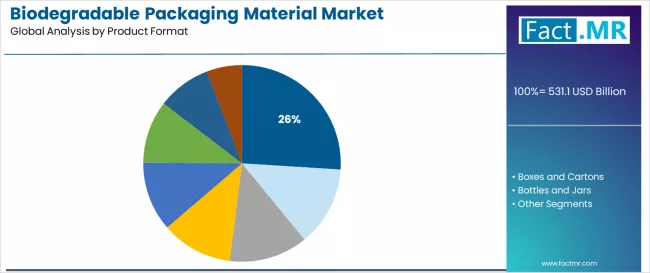
Pouches and bags dominate the biodegradable packaging material format landscape with a 26.0% market share in 2025, reflecting the critical role of flexible packaging in supporting lightweight distribution and material efficiency objectives across retail and food service markets worldwide. The pouches and bags segment's market leadership is reinforced by converter preferences for flexible format advantages, material reduction benefits, and consumer convenience features combined with efficient transportation characteristics in distribution networks.
Within this segment, stand-up pouches and retail shopping bags represent substantial share, driven by brand preference for shelf presence optimization where biodegradable flexible packaging provides product visibility in competitive retail environments. This sub-segment benefits from established sealing technologies and barrier coating innovations that enable product protection.
The boxes and cartons segment represents a significant product format category with 19.8% share, demonstrating strong utilization through specialized requirements for secondary packaging, shipping protection, and point-of-sale display in retail and e-commerce channels. This segment benefits from renewable fiber content that supports recycling infrastructure integration.
The bottles and jars segment maintains meaningful presence with 14.7% share through beverage container applications and personal care packaging, while other categories include films and wraps, trays and clamshells, cups and bowls, cans, and specialty formats serving specific product requirements.
Key market dynamics supporting product format growth include:
- Flexible packaging conversion driven by lightweighting mandates, requiring material-efficient solutions in retail distribution
- Rigid container modernization trends require bio-based alternatives for beverage bottles and food storage applications
- Integration of multi-material structures enabling enhanced barrier performance and product protection across sensitive food categories
- Growing emphasis on portion control packaging driving single-serve format adoption in food service channels without traditional plastic waste
By End Use, Which Segment Accounts for a Significant Market Share?
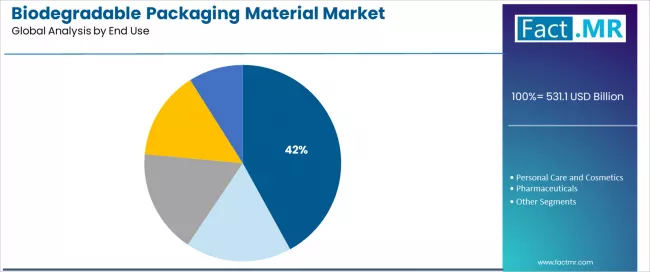
Food and beverages applications represent the leading end-use segment in the biodegradable packaging material market with a 42.0% market share in 2025, reflecting the extensive packaging requirements in food production, retail distribution, and food service operations. The food and beverages segment demonstrates consistent demand driven by fresh produce packaging needs, prepared meal containers, beverage bottles, and food service disposables across diverse product categories and consumption occasions.
The personal care and cosmetics segment emerges as an important end-use category with 21.5% market share in 2025, driven by brand sustainability commitments and consumer preferences for natural product positioning in beauty and personal care channels. Brand owners require packaging solutions capable of supporting premium product presentation while maintaining environmental responsibility credentials.
Within food and beverages applications, fresh produce packaging and take-out food containers demonstrate strong demand for compostable materials that support food waste collection systems. Personal care brands prioritize bio-based bottles and tubes that align with natural ingredient positioning, while pharmaceutical applications encompass blister packs and secondary packaging with regulatory compliance requirements.
Key end-use dynamics include:
- Food packaging consumption accelerating across organized retail expansion with emphasis on fresh food merchandising and grab-and-go formats
- Personal care segment requirements driving premium packaging aesthetics and brand differentiation through environmental credentials
- Pharmaceutical applications emphasizing regulatory compliance and tamper-evidence features in biodegradable material formats
- Food service disposables prioritizing compostable certification and food waste management system compatibility
What are the Drivers, Restraints, and Key Trends of the Biodegradable Packaging Material Market?
The market is driven by three concrete demand factors tied to environmental outcomes. First, stringent regulatory frameworks banning single-use plastics create mandatory demand for biodegradable packaging material alternatives, with legislative action representing decisive intervention against plastic pollution worldwide, requiring immediate material substitution. Second, corporate sustainability commitments and retailer packaging mandates drive accelerated adoption of compostable packaging solutions, with major brands establishing plastic elimination targets and zero-waste objectives requiring comprehensive packaging transformation by 2030. Third, technological advancements in bio-polymer chemistry and barrier coating systems enable more competitive and functional biodegradable materials that improve application suitability while reducing cost differentials and performance limitations.
Market restraints include significant cost premiums compared to conventional plastic packaging that can challenge adoption economics, particularly in price-sensitive product categories where packaging represents substantial cost components and margin pressures limit investment in premium materials. Limited composting infrastructure availability for industrial and home composting poses another significant challenge, as biodegradable packaging material requires appropriate end-of-life processing facilities to achieve environmental benefits, potentially affecting consumer acceptance and waste management integration. Material performance limitations in high-barrier applications and extended shelf-life requirements create additional complexity for manufacturers, demanding continuous innovation and application-specific development initiatives.
Key trends indicate accelerated development of home-compostable materials in developed markets, particularly Europe and North America, where consumers demonstrate preference for backyard composting solutions and decentralized waste management approaches. Extended producer responsibility scheme implementation trends toward packaging take-back obligations with composting infrastructure investment requirements enable systemic solutions that optimize material recovery and environmental impact reduction. However, the market thesis could face disruption if significant advances in chemical recycling technologies or breakthrough innovations in conventional plastic biodegradation reduce differentiation advantages for bio-based packaging materials.
Analysis of the Biodegradable Packaging Material Market by Key Countries
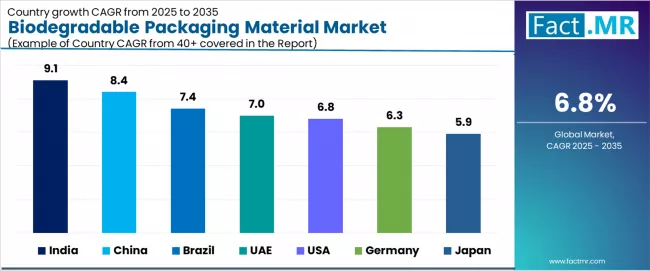
| Country | CAGR (2025-2035) |
|---|---|
| India | 9.1% |
| China | 8.4% |
| Brazil | 7.4% |
| UAE | 7.0% |
| usa | 6.8% |
| Germany | 6.3% |
| Japan | 5.9% |
The global biodegradable packaging material market is expanding steadily, with India leading at a 9.1% CAGR through 2035, driven by strong adoption across fast-moving consumer goods sectors and rapid food delivery industry growth. China follows at 8.4%, supported by large-scale bans on single-use plastics and government environmental protection initiatives. Brazil records 7.4%, reflecting rising retail adoption and environmental awareness in consumer markets.
The UAE grows at 7.0%, anchored by national plastic ban initiatives and green economy diversification strategies. USA advances at 6.8%, leveraging regulatory momentum and consumer preferences. Germany posts 6.3%, focusing on European Union Single-Use Plastics Directive compliance and advanced recycling systems, while Japan grows steadily at 5.9%, emphasizing packaging innovation and demographic consumption patterns.
How is India Leading Global Market Expansion?
India demonstrates the strongest growth potential in the biodegradable packaging material market with a CAGR of 9.1% through 2035. The country's leadership position stems from explosive growth in organized retail, booming food delivery platforms, and government plastic ban implementation driving rapid adoption of alternative packaging materials.
Growth is concentrated in major metropolitan areas and tier-1 cities, including Mumbai, Delhi, Bangalore, and Hyderabad, where food service operators and e-commerce companies are transitioning from conventional plastics to compostable packaging for delivery applications and retail distribution.
Distribution channels through packaging converters and material suppliers expand product accessibility across fast-moving consumer goods manufacturers and quick-service restaurant chains. The country's growing middle-class consumption patterns and smartphone-enabled food delivery services provide strong momentum for biodegradable packaging material category expansion, including comprehensive adoption across organized food retail and modern trade channels.
Key market factors:
- Food delivery sector expansion concentrated in metropolitan areas with smartphone penetration driving packaging volume growth
- Regulatory implementation through state-level plastic bans enabling market development and compliance requirements
- Comprehensive manufacturing investment ecosystem, including domestic bio-plastic production facilities with competitive cost structures
- Local innovation development featuring companies like Greenhope offering regionally appropriate material solutions
Why is China Emerging as a High-Growth Market?
In major urban centers including Beijing, Shanghai, Shenzhen, and Guangzhou, the adoption of biodegradable packaging material solutions is accelerating across retail, food service, and e-commerce applications, driven by comprehensive single-use plastic bans and environmental protection campaign enforcement. The market demonstrates strong growth momentum with a CAGR of 8.4% through 2035, linked to national waste management modernization and increasing focus on circular economy principles with extended producer responsibility frameworks.
Chinese manufacturers are implementing advanced bio-material production and establishing domestic supply chains to support growing packaging demand while meeting government environmental targets. The country's massive consumer market creates ongoing demand for sustainable packaging solutions, while increasing export requirements drive adoption of internationally certified compostable materials.
Key development areas:
- Retail chains and food service operators leading biodegradable packaging material adoption with emphasis on regulatory compliance
- Manufacturing capacity expansion through both domestic bio-plastic producers and international material suppliers establishing local operations
- E-commerce integration enabling compostable mailer adoption and sustainable packaging messaging in online retail channels
- Government policy support through plastic ban enforcement alongside composting infrastructure investment initiatives
What Drives USA Market Resilience?
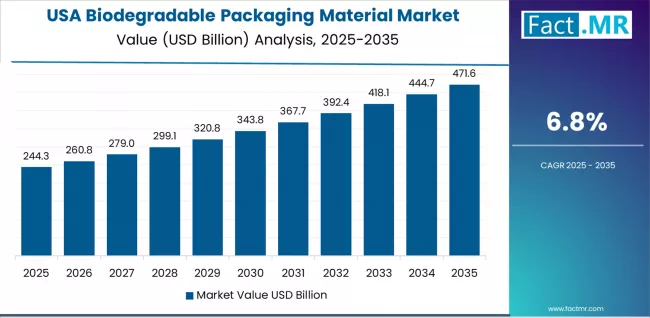
usa market expansion is driven by state-level legislative action, including California, New York, and Washington plastic bag bans requiring retail transition to compostable alternatives. The country demonstrates steady growth potential with a CAGR of 6.8% through 2035, supported by continuous material innovation from packaging manufacturers and corporate sustainability commitments from major consumer brands. American companies face implementation challenges related to composting infrastructure availability and consumer confusion regarding proper disposal, requiring clear labeling and comprehensive education initiatives.
However, established consumer environmental consciousness and brand leadership in packaging innovation create stable baseline demand for biodegradable materials, particularly in food service applications where municipalities mandate compostable foodware for commercial operations.
Market characteristics:
- Food service and retail segments showing robust demand with substantial conversion from conventional plastics across coastal markets
- Regional preferences varying between municipal composting program availability and landfill diversion policy requirements
- Future projections indicate continued corporate packaging transformation with emphasis on measurable plastic reduction targets
- Growing emphasis on certification standards and end-of-life verification supporting consumer confidence and regulatory acceptance
How does Germany Demonstrate Regulatory Leadership?
The German market leads in comprehensive packaging legislation based on integration with European Union Single-Use Plastics Directive requirements and national packaging ordinance frameworks for extended producer responsibility. The country shows strong potential with a CAGR of 6.3% through 2035, driven by established waste management infrastructure and consumer preferences for certified compostable materials in major markets, including Bavaria, North Rhine-Westphalia, Baden-Württemberg, and Hesse.
German retailers are adopting biodegradable packaging material solutions and eliminating conventional plastics for produce packaging and shopping bags, particularly in supermarket chains and discount retailers implementing comprehensive environmental strategies. Distribution channels through established converter networks and material distributors expand coverage across food manufacturers and packaging end-users.
Leading market segments:
- Organized retail adoption in major supermarket chains implementing comprehensive plastic elimination programs
- Manufacturing partnerships with bio-plastic producers achieving scale economies through vertical integration
- Strategic collaborations between packaging converters and waste management operators expanding composting infrastructure
- Focus on DIN CERTCO certification and home-compostable materials addressing consumer disposal requirements
What Positions UAE for Sustainable Development?
In Dubai, Abu Dhabi, and other Emirates, retail establishments are implementing biodegradable packaging material solutions featuring certified compostable materials and natural fiber alternatives, with documented government initiatives showing substantial commitment through national plastic reduction strategies and green economy frameworks. The market shows strong growth potential with a CAGR of 7.0% through 2035, linked to ongoing plastic ban implementation, tourism sector initiatives, and national environmental vision programs in major Emirates.
UAE consumers and hospitality operators are adopting biodegradable packaging material for retail shopping and food service applications to align with government sustainability mandates while maintaining service quality standards. The country's ambitious environmental leadership creates ongoing opportunities for packaging innovation that differentiates through regulatory compliance and international best practices.
Market development factors:
- Hospitality and retail sectors leading adoption of biodegradable packaging material products across UAE
- Government initiatives providing regulatory momentum through plastic ban enforcement and green procurement policies
- Strategic partnerships between international packaging suppliers and local distributors expanding product availability
- Emphasis on tourism sector environmental credentials and global sustainability positioning
How does Brazil Show Latin American Leadership?
In major metropolitan centers including São Paulo, Rio de Janeiro, Brasília, and Belo Horizonte, the adoption of biodegradable packaging material solutions is expanding across retail and food service applications, driven by rising environmental awareness and organized retail sector growth. The market demonstrates solid growth potential with a CAGR of 7.4% through 2035, linked to expanding middle-class consumption and increasing focus on packaging waste reduction in urban environments.
Brazilian retailers are implementing modern packaging practices and adopting compostable alternatives to enhance environmental positioning while meeting consumer expectations. The country's growing retail infrastructure creates ongoing demand for functional biodegradable materials, while increasing corporate responsibility emphasis drives adoption of certified sustainable packaging solutions.
Key development areas:
- Retail chains and food service establishments leading biodegradable packaging material adoption with emphasis on brand differentiation
- Manufacturing development through domestic converter capacity and imported material availability
- Consumer awareness growth supporting premium positioning for environmentally responsible packaging choices
- Municipal waste management evolution driving composting program development in major urban centers
What Characterizes Japan's Market Development?
The Japan market demonstrates mature and innovation-focused characteristics based on advanced packaging technologies and quality-oriented consumer preferences for functional materials. The country shows moderate growth potential with a CAGR of 5.9% through 2035, driven by established retail practices and demographic factors including aging population convenience requirements in major markets, including Tokyo, Osaka, Nagoya, and Fukuoka.
Japanese consumers are maintaining consistent preference for hygienic packaging and purchasing pre-packaged food products with comprehensive protection, creating opportunities for biodegradable material substitution in existing formats. Distribution channels through established converter relationships and material suppliers expand coverage across food manufacturers and retail chains.
Leading market segments:
- Food packaging applications in retail and convenience store channels implementing material substitution strategies
- Manufacturing partnerships with bio-plastic suppliers achieving quality standards through rigorous testing protocols
- Strategic focus on marine biodegradation and aquatic environment protection addressing island nation concerns
- Integration of portion packaging and single-serve formats with compostable material alternatives
Europe Market Split by Country
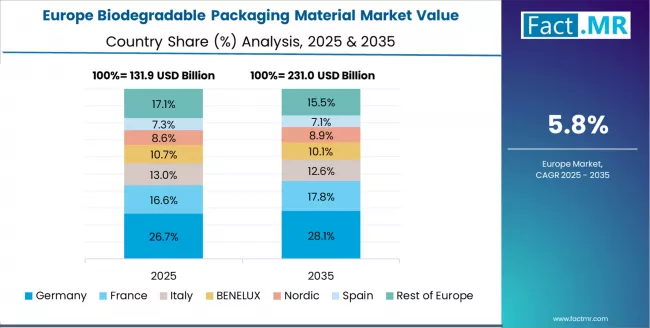
The biodegradable packaging material market in Europe is projected to grow from USD 148.3 billion in 2025 to USD 274.2 billion by 2035, registering a CAGR of 6.3% over the forecast period. Germany is expected to maintain its leadership position with a 28.5% market share in 2025, adjusting slightly to 28.1% by 2035, supported by its comprehensive packaging legislation, established composting infrastructure, and extensive retail commitment to plastic elimination serving major European markets.
The UK follows with a 21.0% share in 2025, projected to reach 21.4% by 2035, driven by comprehensive plastic packaging tax implementation in major regions and retailer voluntary commitments. France holds a 19.5% share in 2025, expected to maintain 19.3% by 2035 through ongoing development of anti-waste legislation and circular economy roadmap initiatives.
Italy commands a 15.0% share, while Spain accounts for 12.5% in 2025. The rest of Europe region is anticipated to gain momentum, expanding its collective share from 3.5% to 3.7% by 2035, attributed to increasing biodegradable packaging material adoption in Nordic countries and emerging Eastern European markets implementing European Union directive compliance programs.
How does Circular Economy Define Biodegradable packaging material Adoption in Japan?
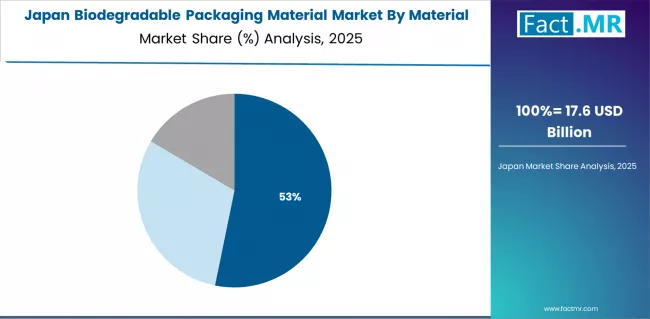
The Japanese biodegradable packaging material market demonstrates a mature and innovation-focused landscape, characterized by sophisticated integration of material science principles with demographic consumption patterns across retail food packaging, convenience store applications, and e-commerce distribution systems. Japan's emphasis on packaging hygiene and product protection drives demand for high-performance biodegradable materials that support comprehensive food safety initiatives and quality preservation requirements in temperature-controlled distribution.
The market benefits from strong partnerships between international material suppliers, domestic packaging converters, and established retail chains, creating comprehensive supply ecosystems that prioritize functional validation and regulatory compliance programs. Metropolitan consumer segments showcase advanced biodegradable packaging material implementations where convenience format optimization achieves waste reduction improvements through integrated collection systems and municipal composting infrastructure.
What Drives Material Innovation in South Korea's Market?
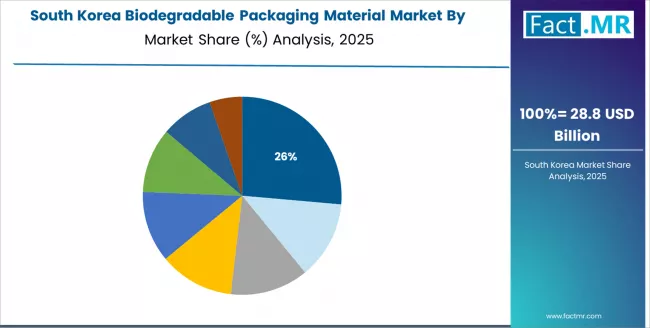
The South Korean biodegradable packaging material market is characterized by growing regulatory pressure on plastic reduction, with companies like domestic packaging manufacturers and international material suppliers maintaining positions through innovative bio-plastic formulations and advanced barrier technologies for retail and food service applications.
The market is demonstrating an increasing emphasis on ocean plastic prevention and coastal environment protection, as Korean government and industry increasingly demand effective biodegradable alternatives that combine functional performance with marine degradation capabilities deployed across urban retail and delivery service channels.
Local material innovations and converter technology development are gaining market share through strategic emphasis on certified compostable films, offering specialized solutions including algae-based materials and agricultural residue composites for comprehensive packaging applications. The competitive landscape shows increasing collaboration between chemical companies and packaging converters, creating integrated development models that combine polymer science expertise with application engineering capabilities and sustainability certification programs.
Competitive Landscape of the Biodegradable packaging material Market
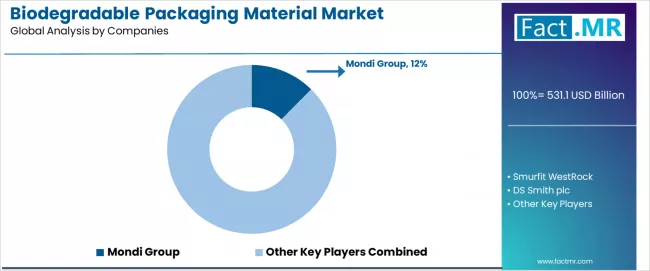
The biodegradable packaging material market features approximately 20-25 meaningful players with moderate concentration, where the top three companies control roughly 30-35% of global market share through established manufacturing footprints and comprehensive material portfolios. Competition centers on material innovation, certification credentials, and converter relationships rather than price competition alone.
Market leaders include Mondi, Smurfit Westrock, and DS Smith, which maintain competitive advantages through comprehensive biodegradable packaging material product portfolios, advanced material science capabilities, and deep expertise in the paper-based packaging sector, creating strong customer relationships and technical credibility. These companies leverage established converter operations and ongoing research and development initiatives to defend market positions while expanding into adjacent categories including bio-plastic laminates and compostable barrier coatings.
Challengers encompass Stora Enso and Sonoco Products Company, which compete through specialized fiber-based expertise and strong market presence in key European and North American packaging markets. Packaging specialists, including Tetra Pak, Amcor plc, and Elevate Packaging, focus on specific application segments or material technologies, offering differentiated capabilities in liquid packaging, flexible films, and molded fiber solutions.
Emerging bio-plastic manufacturers and specialty material companies create competitive pressure through innovative polymer formulations and novel feedstock approaches, particularly in high-growth markets including India and China, where local production capabilities provide advantages in cost positioning and regional supply chain integration.
Market dynamics favor companies that combine advanced material technologies with comprehensive converting capabilities that address the complete value chain from feedstock sourcing through finished packaging production and end-of-life certification programs. Strategic emphasis on industrial composting partnerships, certification body relationships, and brand collaboration initiatives enables differentiation in increasingly sustainability-focused procurement decisions across consumer goods and food service sectors.
Global Biodegradable Packaging Material Market - Stakeholder Contribution Framework
Biodegradable packaging material solutions represent critical material alternatives that enable brand owners, retailers, and food service operators to eliminate plastic pollution and achieve circular economy objectives without compromising product protection requirements, typically providing adequate barrier performance and structural integrity compared to conventional petroleum-based packaging alternatives while ensuring verified environmental degradation and waste management system compatibility.
With the market projected to grow from USD 531.1 billion in 2025 to USD 1,025.6 billion by 2035 at a 6.8% CAGR, these solutions offer compelling advantages - proven environmental benefits, regulatory compliance capabilities, and consumer acceptance characteristics - making them essential for food and beverages applications (42.0% market share), pouches and bags formats (26.0% share), and diverse industry sectors seeking plastic elimination solutions. Scaling market penetration and material adoption requires coordinated action across legislative frameworks, composting infrastructure development, material manufacturers, brand owners, and consumer education initiatives.
How Could Governments Spur Local Development and Adoption?
- Legislative Programs: Implement comprehensive single-use plastic bans with clear enforcement mechanisms, providing phased transition timelines for industry compliance and supporting manufacturers through technical assistance and certification guidance.
- Infrastructure Investment & Support: Fund industrial composting facility development and organic waste collection systems, provide capital grants for bio-plastic production capacity, and establish favorable procurement policies that prioritize certified compostable packaging in government operations.
- Regulatory Framework Development: Create harmonized compostability standards across jurisdictions, establish clear certification requirements for biodegradable packaging material claims, and develop international mutual recognition agreements that facilitate cross-border trade.
- Research & Innovation Funding: Support university research programs on bio-polymer development, barrier technology advancement, and agricultural feedstock optimization. Invest in public-private partnerships that bridge material science innovation with commercial production scalability.
- Extended Producer Responsibility: Establish packaging take-back obligations with composting infrastructure funding requirements, create material-specific fees that internalize environmental costs, and develop circular economy frameworks that encourage packaging optimization and waste reduction.
How Could Industry Bodies Support Market Development?
- Certification Standards & Testing: Define standardized compostability testing protocols across industrial and home composting conditions, establish universal biodegradation measurement methodologies, and create certification programs for packaging materials that ensure environmental claim accuracy.
- Market Education & Best Practices: Lead industry messaging that demonstrates biodegradable packaging material advantages, emphasizing plastic pollution reduction, waste management integration, and verified environmental benefits compared to conventional packaging alternatives.
- Supply Chain Collaboration: Develop guidelines for material specifications, converter processing parameters, and end-of-life sorting protocols, ensuring seamless integration across packaging value chains and waste management systems.
- Technical Training: Run certification programs for packaging designers, production technicians, and quality control personnel on optimizing biodegradable material processing, barrier coating application, and compostability performance verification.
How Could Manufacturers and Material Suppliers Strengthen the Ecosystem?
- Advanced Material Development: Develop next-generation bio-polymers with enhanced barrier properties, improved processing characteristics, and application-specific performance attributes that enable broader packaging category substitution while maintaining cost competitiveness.
- Production Capacity Investment: Provide large-scale bio-plastic manufacturing facilities, integrated fiber processing operations, and regional production networks that reduce material costs through economies of scale and local supply chain optimization.
- Technical Support Programs: Offer comprehensive converter training resources, application development assistance, and troubleshooting services that help packaging manufacturers optimize biodegradable material processing and achieve consistent quality outcomes.
- Certification & Validation: Build comprehensive testing capabilities, third-party certification relationships, and life cycle assessment documentation that ensure biodegradable packaging material products meet regulatory requirements and environmental performance claims.
How Could Brand Owners and Retailers Navigate the Market?
- Packaging Transformation Strategies: Implement comprehensive plastic elimination programs across bio-plastic materials (51.0% market dominance), paper-based alternatives, and innovative formats, with particular focus on high-volume categories and visible consumer touchpoints.
- Geographic Deployment Priorities: Establish biodegradable packaging material adoption in high-growth markets like India (9.1% CAGR) and China (8.4% CAGR), while accelerating conversion in regulated markets like USA (6.8% CAGR) and Germany (6.3% CAGR) through coordinated supplier partnerships.
- Supply Chain Integration: Develop long-term material supply agreements, converter qualification programs, and logistics optimization strategies that ensure reliable material availability and consistent packaging quality across production facilities.
- Consumer Communication: Create transparent labeling systems, disposal guidance programs, and environmental impact messaging that build consumer understanding and support proper end-of-life management behaviors.
How Could Investors and Financial Enablers Unlock Value?
- Material Production Financing: Provide growth capital for established companies like Mondi, Stora Enso, and Tetra Pak to expand bio-plastic production capacity and converting capabilities, particularly in emerging markets with growing packaging demand.
- Innovation Investment: Back startups developing breakthrough bio-polymer chemistries, novel barrier coating systems, and alternative feedstock processing technologies that enhance material performance and cost competitiveness.
- Infrastructure Development Funding: Finance composting facility construction, organic waste collection system deployment, and packaging recovery network establishment supporting circular economy integration.
- Consolidation & Integration Opportunities: Support strategic acquisitions and vertical integration that create material-to-packaging value chains, improve supply security, and enhance competitive positioning across fragmented regional markets.
Key Players in the Biodegradable Packaging Material Market
- Mondi Group
- Smurfit WestRock
- DS Smith plc
- Stora Enso Oyj
- Sonoco Products Company
- Tetra Pak International S.A.
- Amcor plc
- Elevate Packaging, Inc.
- Notpla Limited
- Greenhope (PT Green Hope Indonesia)
Scope of the Report
| Items | Values |
|---|---|
| Quantitative Units | USD 531.1 Billion |
| Material | Bio-plastic, Paper and Paperboard, Bagasse |
| Product Format | Pouches and Bags, Boxes and Cartons, Bottles and Jars, Films and Wraps, Trays and Clamshells, Cups and Bowls, Cans, Others |
| End Use | Food and Beverages, Personal Care and Cosmetics, Pharmaceuticals, Homecare, Others |
| Regions Covered | Asia Pacific, Europe, North America, Latin America, mea |
| Country Covered | India, China, USA, Germany, Brazil, UAE, Japan, and 40+ countries |
| Key Companies Profiled | Mondi, Smurfit Westrock, DS Smith, Stora Enso, Sonoco Products Company, Tetra Pak, Amcor plc, Elevate Packaging, Notpla Limited, Greenhope |
| Additional Attributes | Dollar sales by material and product format categories, regional adoption trends across Asia Pacific, Europe, and North America, competitive landscape with packaging manufacturers and material suppliers, product specifications and compostability requirements, integration with circular economy initiatives and waste management infrastructure, innovations in bio-polymer chemistry and barrier coating technologies, and development of specialized applications with food contact compliance and home-compostable certification capabilities. |
Biodegradable packaging material Market by Segments
-
Material :
- Bio-plastic
- Paper and Paperboard
- Bagasse
-
Product Format :
- Pouches and Bags
- Boxes and Cartons
- Bottles and Jars
- Films and Wraps
- Trays and Clamshells
- Cups and Bowls
- Cans
- Others
-
End Use :
- Food and Beverages
- Personal Care and Cosmetics
- Pharmaceuticals
- Homecare
- Others
-
Region :
- Asia Pacific
- China
- Japan
- South Korea
- India
- Australia & New Zealand
- ASEAN
- Rest of Asia Pacific
- Europe
- Germany
- UK
- France
- Italy
- Spain
- Nordic
- BENELUX
- Rest of Europe
- North America
- USA
- Canada
- Mexico
- Latin America
- Brazil
- Chile
- Rest of Latin America
- MEA
- Kingdom of Saudi Arabia
- Other GCC Countries
- Turkey
- South Africa
- Other African Union
- Rest of mea
- Asia Pacific
Table of Content
- Executive Summary
- Global Market Outlook
- Demand to side Trends
- Supply to side Trends
- Technology Roadmap Analysis
- Analysis and Recommendations
- Market Overview
- Market Coverage / Taxonomy
- Market Definition / Scope / Limitations
- Market Background
- Market Dynamics
- Drivers
- Restraints
- Opportunity
- Trends
- Scenario Forecast
- Demand in Optimistic Scenario
- Demand in Likely Scenario
- Demand in Conservative Scenario
- Opportunity Map Analysis
- Product Life Cycle Analysis
- Supply Chain Analysis
- Investment Feasibility Matrix
- Value Chain Analysis
- PESTLE and Porter’s Analysis
- Regulatory Landscape
- Regional Parent Market Outlook
- Production and Consumption Statistics
- Import and Export Statistics
- Market Dynamics
- Global Market Analysis 2020 to 2024 and Forecast, 2025 to 2035
- Historical Market Size Value (USD Million) Analysis, 2020 to 2024
- Current and Future Market Size Value (USD Million) Projections, 2025 to 2035
- Y to o to Y Growth Trend Analysis
- Absolute $ Opportunity Analysis
- Global Market Pricing Analysis 2020 to 2024 and Forecast 2025 to 2035
- Global Market Analysis 2020 to 2024 and Forecast 2025 to 2035, By Material
- Introduction / Key Findings
- Historical Market Size Value (USD Million) Analysis By Material, 2020 to 2024
- Current and Future Market Size Value (USD Million) Analysis and Forecast By Material, 2025 to 2035
- Bio-plastic
- Paper and Paperboard
- Bagasse
- Y to o to Y Growth Trend Analysis By Material, 2020 to 2024
- Absolute $ Opportunity Analysis By Material, 2025 to 2035
- Global Market Analysis 2020 to 2024 and Forecast 2025 to 2035, By Product Format
- Introduction / Key Findings
- Historical Market Size Value (USD Million) Analysis By Product Format, 2020 to 2024
- Current and Future Market Size Value (USD Million) Analysis and Forecast By Product Format, 2025 to 2035
- Pouches and Bags
- Boxes and Cartons
- Bottles and Jars
- Films and Wraps
- Trays and Clamshells
- Cups and Bowls
- Cans
- Others
- Y to o to Y Growth Trend Analysis By Product Format, 2020 to 2024
- Absolute $ Opportunity Analysis By Product Format, 2025 to 2035
- Global Market Analysis 2020 to 2024 and Forecast 2025 to 2035, By End Use
- Introduction / Key Findings
- Historical Market Size Value (USD Million) Analysis By End Use, 2020 to 2024
- Current and Future Market Size Value (USD Million) Analysis and Forecast By End Use, 2025 to 2035
- Food and Beverages
- Personal Care and Cosmetics
- Pharmaceuticals
- Homecare
- Others
- Y to o to Y Growth Trend Analysis By End Use, 2020 to 2024
- Absolute $ Opportunity Analysis By End Use, 2025 to 2035
- Global Market Analysis 2020 to 2024 and Forecast 2025 to 2035, By Region
- Introduction
- Historical Market Size Value (USD Million) Analysis By Region, 2020 to 2024
- Current Market Size Value (USD Million) Analysis and Forecast By Region, 2025 to 2035
- North America
- Latin America
- Western Europe
- Eastern Europe
- East Asia
- South Asia and Pacific
- Middle East & Africa
- Market Attractiveness Analysis By Region
- North America Market Analysis 2020 to 2024 and Forecast 2025 to 2035, By Country
- Historical Market Size Value (USD Million) Trend Analysis By Market Taxonomy, 2020 to 2024
- Market Size Value (USD Million) Forecast By Market Taxonomy, 2025 to 2035
- By Country
- USA
- Canada
- Mexico
- By Material
- By Product Format
- By End Use
- By Country
- Market Attractiveness Analysis
- By Country
- By Material
- By Product Format
- By End Use
- Key Takeaways
- Latin America Market Analysis 2020 to 2024 and Forecast 2025 to 2035, By Country
- Historical Market Size Value (USD Million) Trend Analysis By Market Taxonomy, 2020 to 2024
- Market Size Value (USD Million) Forecast By Market Taxonomy, 2025 to 2035
- By Country
- Brazil
- Chile
- Rest of Latin America
- By Material
- By Product Format
- By End Use
- By Country
- Market Attractiveness Analysis
- By Country
- By Material
- By Product Format
- By End Use
- Key Takeaways
- Western Europe Market Analysis 2020 to 2024 and Forecast 2025 to 2035, By Country
- Historical Market Size Value (USD Million) Trend Analysis By Market Taxonomy, 2020 to 2024
- Market Size Value (USD Million) Forecast By Market Taxonomy, 2025 to 2035
- By Country
- Germany
- UK
- Italy
- Spain
- France
- Nordic
- BENELUX
- Rest of Western Europe
- By Material
- By Product Format
- By End Use
- By Country
- Market Attractiveness Analysis
- By Country
- By Material
- By Product Format
- By End Use
- Key Takeaways
- Eastern Europe Market Analysis 2020 to 2024 and Forecast 2025 to 2035, By Country
- Historical Market Size Value (USD Million) Trend Analysis By Market Taxonomy, 2020 to 2024
- Market Size Value (USD Million) Forecast By Market Taxonomy, 2025 to 2035
- By Country
- Russia
- Poland
- Hungary
- Balkan & Baltic
- Rest of Eastern Europe
- By Material
- By Product Format
- By End Use
- By Country
- Market Attractiveness Analysis
- By Country
- By Material
- By Product Format
- By End Use
- Key Takeaways
- East Asia Market Analysis 2020 to 2024 and Forecast 2025 to 2035, By Country
- Historical Market Size Value (USD Million) Trend Analysis By Market Taxonomy, 2020 to 2024
- Market Size Value (USD Million) Forecast By Market Taxonomy, 2025 to 2035
- By Country
- China
- Japan
- South Korea
- By Material
- By Product Format
- By End Use
- By Country
- Market Attractiveness Analysis
- By Country
- By Material
- By Product Format
- By End Use
- Key Takeaways
- South Asia and Pacific Market Analysis 2020 to 2024 and Forecast 2025 to 2035, By Country
- Historical Market Size Value (USD Million) Trend Analysis By Market Taxonomy, 2020 to 2024
- Market Size Value (USD Million) Forecast By Market Taxonomy, 2025 to 2035
- By Country
- India
- ASEAN
- Australia & New Zealand
- Rest of South Asia and Pacific
- By Material
- By Product Format
- By End Use
- By Country
- Market Attractiveness Analysis
- By Country
- By Material
- By Product Format
- By End Use
- Key Takeaways
- Middle East & Africa Market Analysis 2020 to 2024 and Forecast 2025 to 2035, By Country
- Historical Market Size Value (USD Million) Trend Analysis By Market Taxonomy, 2020 to 2024
- Market Size Value (USD Million) Forecast By Market Taxonomy, 2025 to 2035
- By Country
- Kingdom of Saudi Arabia
- Other GCC Countries
- Turkiye
- South Africa
- Other African Union
- Rest of Middle East & Africa
- By Material
- By Product Format
- By End Use
- By Country
- Market Attractiveness Analysis
- By Country
- By Material
- By Product Format
- By End Use
- Key Takeaways
- Key Countries Market Analysis
- USA
- Pricing Analysis
- Market Share Analysis, 2024
- By Material
- By Product Format
- By End Use
- Canada
- Pricing Analysis
- Market Share Analysis, 2024
- By Material
- By Product Format
- By End Use
- Mexico
- Pricing Analysis
- Market Share Analysis, 2024
- By Material
- By Product Format
- By End Use
- Brazil
- Pricing Analysis
- Market Share Analysis, 2024
- By Material
- By Product Format
- By End Use
- Chile
- Pricing Analysis
- Market Share Analysis, 2024
- By Material
- By Product Format
- By End Use
- Germany
- Pricing Analysis
- Market Share Analysis, 2024
- By Material
- By Product Format
- By End Use
- UK
- Pricing Analysis
- Market Share Analysis, 2024
- By Material
- By Product Format
- By End Use
- Italy
- Pricing Analysis
- Market Share Analysis, 2024
- By Material
- By Product Format
- By End Use
- Spain
- Pricing Analysis
- Market Share Analysis, 2024
- By Material
- By Product Format
- By End Use
- France
- Pricing Analysis
- Market Share Analysis, 2024
- By Material
- By Product Format
- By End Use
- India
- Pricing Analysis
- Market Share Analysis, 2024
- By Material
- By Product Format
- By End Use
- ASEAN
- Pricing Analysis
- Market Share Analysis, 2024
- By Material
- By Product Format
- By End Use
- Australia & New Zealand
- Pricing Analysis
- Market Share Analysis, 2024
- By Material
- By Product Format
- By End Use
- China
- Pricing Analysis
- Market Share Analysis, 2024
- By Material
- By Product Format
- By End Use
- Japan
- Pricing Analysis
- Market Share Analysis, 2024
- By Material
- By Product Format
- By End Use
- South Korea
- Pricing Analysis
- Market Share Analysis, 2024
- By Material
- By Product Format
- By End Use
- Russia
- Pricing Analysis
- Market Share Analysis, 2024
- By Material
- By Product Format
- By End Use
- Poland
- Pricing Analysis
- Market Share Analysis, 2024
- By Material
- By Product Format
- By End Use
- Hungary
- Pricing Analysis
- Market Share Analysis, 2024
- By Material
- By Product Format
- By End Use
- Kingdom of Saudi Arabia
- Pricing Analysis
- Market Share Analysis, 2024
- By Material
- By Product Format
- By End Use
- Turkiye
- Pricing Analysis
- Market Share Analysis, 2024
- By Material
- By Product Format
- By End Use
- South Africa
- Pricing Analysis
- Market Share Analysis, 2024
- By Material
- By Product Format
- By End Use
- USA
- Market Structure Analysis
- Competition Dashboard
- Competition Benchmarking
- Market Share Analysis of Top Players
- By Regional
- By Material
- By Product Format
- By End Use
- Competition Analysis
- Competition Deep Dive
- Mondi Group
- Overview
- Product Portfolio
- Profitability by Market Segments (Product/Age /Sales Channel/Region)
- Sales Footprint
- Strategy Overview
- Marketing Strategy
- Product Strategy
- Channel Strategy
- Smurfit WestRock
- DS Smith plc
- Stora Enso Oyj
- Sonoco Products Company
- Tetra Pak International S.A.
- Amcor plc
- Elevate Packaging, Inc.
- Notpla Limited
- Greenhope (PT Green Hope Indonesia)
- Mondi Group
- Competition Deep Dive
- Assumptions & Acronyms Used
- Research Methodology
List Of Table
- Table 1: Global Market Value (USD Million) Forecast by Region, 2020 to 2035
- Table 2: Global Market Value (USD Million) Forecast by Material, 2020 to 2035
- Table 3: Global Market Value (USD Million) Forecast by Product Format, 2020 to 2035
- Table 4: Global Market Value (USD Million) Forecast by End Use, 2020 to 2035
- Table 5: North America Market Value (USD Million) Forecast by Country, 2020 to 2035
- Table 6: North America Market Value (USD Million) Forecast by Material, 2020 to 2035
- Table 7: North America Market Value (USD Million) Forecast by Product Format, 2020 to 2035
- Table 8: North America Market Value (USD Million) Forecast by End Use, 2020 to 2035
- Table 9: Latin America Market Value (USD Million) Forecast by Country, 2020 to 2035
- Table 10: Latin America Market Value (USD Million) Forecast by Material, 2020 to 2035
- Table 11: Latin America Market Value (USD Million) Forecast by Product Format, 2020 to 2035
- Table 12: Latin America Market Value (USD Million) Forecast by End Use, 2020 to 2035
- Table 13: Western Europe Market Value (USD Million) Forecast by Country, 2020 to 2035
- Table 14: Western Europe Market Value (USD Million) Forecast by Material, 2020 to 2035
- Table 15: Western Europe Market Value (USD Million) Forecast by Product Format, 2020 to 2035
- Table 16: Western Europe Market Value (USD Million) Forecast by End Use, 2020 to 2035
- Table 17: Eastern Europe Market Value (USD Million) Forecast by Country, 2020 to 2035
- Table 18: Eastern Europe Market Value (USD Million) Forecast by Material, 2020 to 2035
- Table 19: Eastern Europe Market Value (USD Million) Forecast by Product Format, 2020 to 2035
- Table 20: Eastern Europe Market Value (USD Million) Forecast by End Use, 2020 to 2035
- Table 21: East Asia Market Value (USD Million) Forecast by Country, 2020 to 2035
- Table 22: East Asia Market Value (USD Million) Forecast by Material, 2020 to 2035
- Table 23: East Asia Market Value (USD Million) Forecast by Product Format, 2020 to 2035
- Table 24: East Asia Market Value (USD Million) Forecast by End Use, 2020 to 2035
- Table 25: South Asia and Pacific Market Value (USD Million) Forecast by Country, 2020 to 2035
- Table 26: South Asia and Pacific Market Value (USD Million) Forecast by Material, 2020 to 2035
- Table 27: South Asia and Pacific Market Value (USD Million) Forecast by Product Format, 2020 to 2035
- Table 28: South Asia and Pacific Market Value (USD Million) Forecast by End Use, 2020 to 2035
- Table 29: Middle East & Africa Market Value (USD Million) Forecast by Country, 2020 to 2035
- Table 30: Middle East & Africa Market Value (USD Million) Forecast by Material, 2020 to 2035
- Table 31: Middle East & Africa Market Value (USD Million) Forecast by Product Format, 2020 to 2035
- Table 32: Middle East & Africa Market Value (USD Million) Forecast by End Use, 2020 to 2035
List Of Figures
- Figure 1: Global Market Pricing Analysis
- Figure 2: Global Market Value (USD Million) Forecast 2020 to 2035
- Figure 3: Global Market Value Share and BPS Analysis by Material, 2025 and 2035
- Figure 4: Global Market Y to o to Y Growth Comparison by Material, 2025 to 2035
- Figure 5: Global Market Attractiveness Analysis by Material
- Figure 6: Global Market Value Share and BPS Analysis by Product Format, 2025 and 2035
- Figure 7: Global Market Y to o to Y Growth Comparison by Product Format, 2025 to 2035
- Figure 8: Global Market Attractiveness Analysis by Product Format
- Figure 9: Global Market Value Share and BPS Analysis by End Use, 2025 and 2035
- Figure 10: Global Market Y to o to Y Growth Comparison by End Use, 2025 to 2035
- Figure 11: Global Market Attractiveness Analysis by End Use
- Figure 12: Global Market Value (USD Million) Share and BPS Analysis by Region, 2025 and 2035
- Figure 13: Global Market Y to o to Y Growth Comparison by Region, 2025 to 2035
- Figure 14: Global Market Attractiveness Analysis by Region
- Figure 15: North America Market Incremental Dollar Opportunity, 2025 to 2035
- Figure 16: Latin America Market Incremental Dollar Opportunity, 2025 to 2035
- Figure 17: Western Europe Market Incremental Dollar Opportunity, 2025 to 2035
- Figure 18: Eastern Europe Market Incremental Dollar Opportunity, 2025 to 2035
- Figure 19: East Asia Market Incremental Dollar Opportunity, 2025 to 2035
- Figure 20: South Asia and Pacific Market Incremental Dollar Opportunity, 2025 to 2035
- Figure 21: Middle East & Africa Market Incremental Dollar Opportunity, 2025 to 2035
- Figure 22: North America Market Value Share and BPS Analysis by Country, 2025 and 2035
- Figure 23: North America Market Value Share and BPS Analysis by Material, 2025 and 2035
- Figure 24: North America Market Y to o to Y Growth Comparison by Material, 2025 to 2035
- Figure 25: North America Market Attractiveness Analysis by Material
- Figure 26: North America Market Value Share and BPS Analysis by Product Format, 2025 and 2035
- Figure 27: North America Market Y to o to Y Growth Comparison by Product Format, 2025 to 2035
- Figure 28: North America Market Attractiveness Analysis by Product Format
- Figure 29: North America Market Value Share and BPS Analysis by End Use, 2025 and 2035
- Figure 30: North America Market Y to o to Y Growth Comparison by End Use, 2025 to 2035
- Figure 31: North America Market Attractiveness Analysis by End Use
- Figure 32: Latin America Market Value Share and BPS Analysis by Country, 2025 and 2035
- Figure 33: Latin America Market Value Share and BPS Analysis by Material, 2025 and 2035
- Figure 34: Latin America Market Y to o to Y Growth Comparison by Material, 2025 to 2035
- Figure 35: Latin America Market Attractiveness Analysis by Material
- Figure 36: Latin America Market Value Share and BPS Analysis by Product Format, 2025 and 2035
- Figure 37: Latin America Market Y to o to Y Growth Comparison by Product Format, 2025 to 2035
- Figure 38: Latin America Market Attractiveness Analysis by Product Format
- Figure 39: Latin America Market Value Share and BPS Analysis by End Use, 2025 and 2035
- Figure 40: Latin America Market Y to o to Y Growth Comparison by End Use, 2025 to 2035
- Figure 41: Latin America Market Attractiveness Analysis by End Use
- Figure 42: Western Europe Market Value Share and BPS Analysis by Country, 2025 and 2035
- Figure 43: Western Europe Market Value Share and BPS Analysis by Material, 2025 and 2035
- Figure 44: Western Europe Market Y to o to Y Growth Comparison by Material, 2025 to 2035
- Figure 45: Western Europe Market Attractiveness Analysis by Material
- Figure 46: Western Europe Market Value Share and BPS Analysis by Product Format, 2025 and 2035
- Figure 47: Western Europe Market Y to o to Y Growth Comparison by Product Format, 2025 to 2035
- Figure 48: Western Europe Market Attractiveness Analysis by Product Format
- Figure 49: Western Europe Market Value Share and BPS Analysis by End Use, 2025 and 2035
- Figure 50: Western Europe Market Y to o to Y Growth Comparison by End Use, 2025 to 2035
- Figure 51: Western Europe Market Attractiveness Analysis by End Use
- Figure 52: Eastern Europe Market Value Share and BPS Analysis by Country, 2025 and 2035
- Figure 53: Eastern Europe Market Value Share and BPS Analysis by Material, 2025 and 2035
- Figure 54: Eastern Europe Market Y to o to Y Growth Comparison by Material, 2025 to 2035
- Figure 55: Eastern Europe Market Attractiveness Analysis by Material
- Figure 56: Eastern Europe Market Value Share and BPS Analysis by Product Format, 2025 and 2035
- Figure 57: Eastern Europe Market Y to o to Y Growth Comparison by Product Format, 2025 to 2035
- Figure 58: Eastern Europe Market Attractiveness Analysis by Product Format
- Figure 59: Eastern Europe Market Value Share and BPS Analysis by End Use, 2025 and 2035
- Figure 60: Eastern Europe Market Y to o to Y Growth Comparison by End Use, 2025 to 2035
- Figure 61: Eastern Europe Market Attractiveness Analysis by End Use
- Figure 62: East Asia Market Value Share and BPS Analysis by Country, 2025 and 2035
- Figure 63: East Asia Market Value Share and BPS Analysis by Material, 2025 and 2035
- Figure 64: East Asia Market Y to o to Y Growth Comparison by Material, 2025 to 2035
- Figure 65: East Asia Market Attractiveness Analysis by Material
- Figure 66: East Asia Market Value Share and BPS Analysis by Product Format, 2025 and 2035
- Figure 67: East Asia Market Y to o to Y Growth Comparison by Product Format, 2025 to 2035
- Figure 68: East Asia Market Attractiveness Analysis by Product Format
- Figure 69: East Asia Market Value Share and BPS Analysis by End Use, 2025 and 2035
- Figure 70: East Asia Market Y to o to Y Growth Comparison by End Use, 2025 to 2035
- Figure 71: East Asia Market Attractiveness Analysis by End Use
- Figure 72: South Asia and Pacific Market Value Share and BPS Analysis by Country, 2025 and 2035
- Figure 73: South Asia and Pacific Market Value Share and BPS Analysis by Material, 2025 and 2035
- Figure 74: South Asia and Pacific Market Y to o to Y Growth Comparison by Material, 2025 to 2035
- Figure 75: South Asia and Pacific Market Attractiveness Analysis by Material
- Figure 76: South Asia and Pacific Market Value Share and BPS Analysis by Product Format, 2025 and 2035
- Figure 77: South Asia and Pacific Market Y to o to Y Growth Comparison by Product Format, 2025 to 2035
- Figure 78: South Asia and Pacific Market Attractiveness Analysis by Product Format
- Figure 79: South Asia and Pacific Market Value Share and BPS Analysis by End Use, 2025 and 2035
- Figure 80: South Asia and Pacific Market Y to o to Y Growth Comparison by End Use, 2025 to 2035
- Figure 81: South Asia and Pacific Market Attractiveness Analysis by End Use
- Figure 82: Middle East & Africa Market Value Share and BPS Analysis by Country, 2025 and 2035
- Figure 83: Middle East & Africa Market Value Share and BPS Analysis by Material, 2025 and 2035
- Figure 84: Middle East & Africa Market Y to o to Y Growth Comparison by Material, 2025 to 2035
- Figure 85: Middle East & Africa Market Attractiveness Analysis by Material
- Figure 86: Middle East & Africa Market Value Share and BPS Analysis by Product Format, 2025 and 2035
- Figure 87: Middle East & Africa Market Y to o to Y Growth Comparison by Product Format, 2025 to 2035
- Figure 88: Middle East & Africa Market Attractiveness Analysis by Product Format
- Figure 89: Middle East & Africa Market Value Share and BPS Analysis by End Use, 2025 and 2035
- Figure 90: Middle East & Africa Market Y to o to Y Growth Comparison by End Use, 2025 to 2035
- Figure 91: Middle East & Africa Market Attractiveness Analysis by End Use
- Figure 92: Global Market - Tier Structure Analysis
- Figure 93: Global Market - Company Share Analysis
- FAQs -
How big is the biodegradable packaging material market in 2025?
The global biodegradable packaging material market is estimated to be valued at USD 531.1 billion in 2025.
What will be the size of biodegradable packaging material market in 2035?
The market size for the biodegradable packaging material market is projected to reach USD 1,025.6 billion by 2035.
How much will be the biodegradable packaging material market growth between 2025 and 2035?
The biodegradable packaging material market is expected to grow at a 6.8% CAGR between 2025 and 2035.
What are the key product types in the biodegradable packaging material market?
The key product types in biodegradable packaging material market are bio-plastic, paper and paperboard and bagasse.
Which product format segment to contribute significant share in the biodegradable packaging material market in 2025?
In terms of product format, pouches and bags segment to command 26.0% share in the biodegradable packaging material market in 2025.